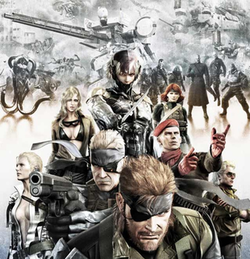After being dormant for fourteen years, Konami has finally taken the initiative to bring back a beloved (and creator) favorite! Metal Gear Solid Δ is a remake of the 2004 PlayStation 2 game. It serves as a (re)imagining of the third installment of Metal Gear Solid, which was directed by Hideo Kojima and has become a cult classic – with the intentions of willingness to honor this while modernizing it for a more contemporary audience.

Introduction
The reveal gave longtime fans nostalgia and excitement while also having an air of intrigue for new audiences. So, what did this remake reintroduce us to, what is being changed, and why is it still relevant today?
SETTING THE STAGE: Which is Metal Gear Solid Δ: Snake Eater?
Metal Gear Solid 3: Snake Eater is a prequel. It presented an origin story of Big Boss, the key soldier to define this series. Set in a Soviet jungle during the Cold War, the game consisted of part stealth-action and part survival. Players were able to hunt for food, dress wounds, and deal with the elements.
The new remake, named Metal Gear Solid Δ: Snake Eater, holds on to that fundamental concept. But it rebuilds the experience using modern infrastructure, and Konami selected Unreal Engine 5, allowing them to showcase some of the finest graphical features and physics.
Why “Δ” Rather Than “3”?
Interestingly, Konami never called the game “Metal Gear Solid 3 Remake,” instead referring to it as the Greek letter “Delta (Δ).” In math, delta represents change without losing meaning. That is exactly what the premise of this remake intends to do; change the presentation while holding on to the essence of the game.
This branding sends a clear message to the fan base that the soul of Snake Eater is intact. It is even still the same story, with the same events and characters in the same timeline. The only things changed are the visuals, the controls and mechanics of gameplay all upgraded.
Visual Overhaul: Gorgeous Jungle Ecosystem
One of the most significant differences in the remake is the visual style. The jungle looks more dynamic and engaging than before. Trees sway back and forth in real-time with the wind. Water reflects sunlight as if made of glass. Everything, including the animals, animates realistically. Everything is believable.
Konami teased gameplay showing Snake crawling (or is he rolling?) through grass, swimming through rivers, and climbing cliffs. These sections look almost photo-real; the visual fidelity gives the jungle a real feeling of danger and mystery. Players will likely feel more “in” the environment than they ever did with the PS2 version.
An excellent rendering of the jungle conveys a much richer, more realistic world than any prior version about which players dreamed. Unreal Engine 5 has allowed players to experience heavier, more detailed, and much more atmospheric effects. Think of the rain hitting leaves, mud sticking to clothes, and extinguished lights when a cloud moves overhead.
Character Models and Voice acting
Character models are also receiving a massive make-over. Snake’s facial animations now show subtle expressions of emotion. His eyes react to light. His clothing wrinkles and gets dirty. Konami likes realism, it appears.
They retained one thing the same: the voice cast. David Hayter is once again Naked Snake, and this is a major win for gamers who see Hayter as the only voice for the character. As have the original recordings returned; so has the game-worthy dialogue that gamers will remember.
Offline nostalgia with real-time, recreation! The blend of original voices with new visual realism allows for a new and recent experience.

Gameplay Mechanics – What is Different?
At the time of its release, Snake Eater’s gameplay was groundbreaking. A game with camouflage, stamina, close-quarters combat (CQC), and real-time healing! And while all of these features remain in the remake, they are cleaned up.
For starters the movement is smoother. The original game had some awkward camera angles, and the controls were fairly limited. The remake fixes both of those by utilizing a modern control scheme. Players are now able to move the camera freely. Aiming and shooting feels more precise.
Combat has also become a lot less rigid when it comes to CQC. Snake is able to grab enemies, throw enemies, and interrogate enemies much more fluidly. The animations are way smoother. Combat feels more cinematic.
The survival mechanics are a lot better too. While players are still required to catch animals, heal wounds, and change clothes for camouflage purposes, the UI is cleaner, and the actions don’t feel painstakingly repetitive. The survival aspects are more enjoyable and less tedious.
Stealth Mechanics and Enemy AI
Stealth remains a heavy gameplay aspect of the franchise. You are not a superhero. You are a soldier, trying to maneuver behind enemy lines. Because of this the AI needs to feel both smart and responsive.
In the remake, enemy soldiers are more cognizant of sound and movement. They will investigate a noise, and if they see real footprints, they will follow them. They will even call for back-up or set traps. This all makes stealthing more intense and more difficult.
Additionally, players are allowed to use the environment in a more engaging way. Players can hide in bushes, throw a can to distract enemies, or silently take them down. Every decision matters.
Narrative: The Birth of Big Boss
The story of Snake Eater is unchanged. This is important because the story is one of the best in gaming history. It invokes emotion, politics, and is deeply personal.
You play Naked Snake. A CIA operative sent to recover a scientist and to stop a nuclear threat. However, you must face your former mentor, The Boss. The relationship is the center of the game.
There’s a lot to unpack concerning The Boss. The Boss is a soldier, an indelible figure with Legendary status. While also being a role model for Snake. But the Boss has defected to the Soviet Union. The way the game works your relationship with the Boss, you start to shake and question everything: loyalty, duty, and crucially, victory.
The last couple of moments still will hit. Even now, players should realise that war is more than just bullets—it’s betrayal, pain, and sacrifice.
The Legacy of Snake Eater
Before we go too far, it’s important to remember why Snake Eater even means so much. It was more than a fun stealth game. It was a watershed moment for storytelling.
In 2004, there were not too many games that dared to be so philosophical. Snake Eater asked some big questions. What is a patriot, for example? What does it mean to be loyal? What do soldiers owe to their countries?
It also included one of the most haunting boss battles to ever experience — the battle with The End. Players had the choice to just wait him out in real time until he died of old age, or just shoot him in the early parts of the level. Now that’s freedom!
The remake honors these elements. It honors the choices and themes that made the original so special.
What’s Missing?
One of the biggest things missing is Hideo Kojima. He created the original and endowed it with his one-of-a-kind gifts. He is no longer working for Konami and is not involved with this remake.
Some fans are worried that will diminish this remake. It will be hard to replicate Kojima’s touch. His writing, pacing, and sense of humor were hugely part of the charm of the series.
However, Konami has stated, that they are greatly relying on the original design documents and voice recordings that used to be a part of the development process. They want to remain true to the original vision of Kojima, despite the limitations of not having him onboard.
Accessibility Features And Modern Features
The remake is also going to offer modern features as accessibility options. Players will be able to customize their font size for subtitles, contrast settings, and further button mapping. There may also be assist modes for those struggling to learn stealth.
These changes allow new players to enjoy the game without being overwhelmed. Whereas hardcore fans will still be able to enjoy harder gameplay settings for the original challenge.
Photo mode is also believed to be available. It allows players to take in-game screenshots of their most powerful visuals. This offers another means of replayability.

Platforms/Releases
Metal Gear Solid Δ: Snake Eater will release on the PlayStation 5, Xbox Series X/S, and PC. There is currently no official release date, but that there are many expectations for it to release in late 2025.
This remake is part of a more extensive plan from Konami to revive the Metal Gear franchise. They also released the Metal Gear Solid: Master Collection Vol. 1, which bundles the first three games as they were originally made.
The remake could simply be a trial to see if they could get away with doing more remakes like Metal Gear Solid 1 or Peace Walker.
Fan Concerns and Expectations
Fans are excited but cautious. They want the remake to succeed, but there are fears that without Kojima, Konami will miss the point.
The good news is, it seems like Konami is serious this time. They have recruited an exceptional development team, they are focusing on high quality, high-fidelity visuals, they are bringing back original voice actors, etc.
If the final product resonates with the spirit of the original experience while also giving players a new and modern experience, then this remake has the potential to be one of the best games of the decade. https://theechowriters.com/category/gaming/
Final Thoughts
Metal Gear Solid Δ: Snake Eater isn’t just a remake. It’s a tribute. It’s a chance to encounter a masterpiece once again, through new eyes. It brings back longtime fans and introduces new ones. https://www.konami.com/mg/mgs3r/gate
It is not often that we see a game mix espionage, emotional engagement, and gameplay with such deftness. Snake Eater did it. Hopefully, this remake does it again.
For now, we just have to wait—and keep quiet!